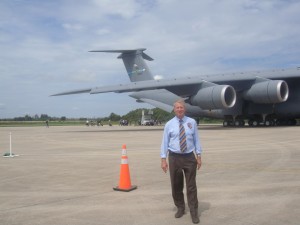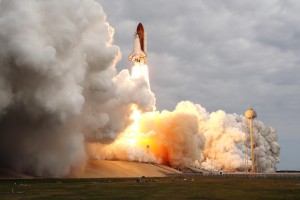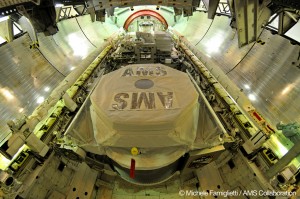When Maurice Bourquin participated in the first meeting between particle physicists and representatives of NASA in Houston, US, to understand the opportunity offered by the International Space Station (ISS) to support a particle physics experiment in space, he probably didn’t expect that his detector would finally fly 17 years later. A pioneer in the Alpha Magnetic Spectrometer experiment led by Nobel Prize laureate Samuel Ting, Bourquin created a team in Switzerland at the University of Geneva to take part in the project. His group took part in the design and the construction of the first version, AMS-01, a concept that took flight aboard Discovery space shuttle in 1998.
Just after the AMS-02 detector was launched, ILC NewsLine captured his first reactions and asked him about the interplay between AMS-02 and collider experiments, which Maurice Bourquin, former president of the CERN Council from 2001 to 2003, is also very familiar with.
ILC NewsLine: 16 May 2011 was a historical day for the AMS collaboration, and for astroparticle physics in general. How did you spend this special day?
Maurice Bourquin: The launch was delayed several times and I was actually at the Kennedy Space Center for the first attempt on 28 April. As I had witnessed several such events in the past, I decided to watch the final preparation and the launch of Endeavour from CERN. We had organised a live webcast where the public had their questions about the project, dark matter and antimatter answered. Two hours later power was applied to AMS, and first data were successfully received.
What is Alpha Magnetic Spectrometer Experiment looking for? Why is the AMS detector being sent into space?
AMS will measure high-energy cosmic rays, which are charged particles, as well as gamma rays, passing through the detector in space. It is particularly suited to identify antiparticles, which could signal primordial antimatter, dark matter or other unknown phenomena. The detector is sent into space, because the earth’s atmosphere protects us from the vast majority of the cosmic particles and antiparticles moving through the universe. This beneficial protection to humans is a barrier to study cosmic phenomena from the Earth.

On 26 August 2010, Maurice Bourquin welcomes the US Air Force C-5M transport plane carrying the AMS-02 detector at the shuttle landing facility at the Kennedy Space Center in Florida.
What are the main challenges for designing and building a detector that will go to space?
The AMS detector instrumentation is based on accelerator physics technology and is designed for maximum performance. However only low power (2500 watts) is available up there for 300,000 channels of detection and 775 boards of electronics! It was also designed with high redundancy as there is no possibility of human intervention on orbit.
And in other words… what’s so different in the design between a detector like AMS and an LHC detector, for example?
While an LHC detector sits in a rather comfortable environment, apart from radiation, a space detector is in a very hostile environment. It has to be space-qualified to resist vibration, must operate flawlessly in microgravity and vacuum and withstand extreme thermal cycles over an extended period of time. It also must be protected from micrometeorites.
How do you see the interplay and synergies between collider experiments like the LHC or the future ILC and AMS?
We are very fortunate that we now have two complementary ways to find a solution to the dark matter problem: the colliders are searching for direct production of heavy particles which could constitute its nature and AMS will study the question through the characteristic distributions of antiparticles in the galaxy.
What kind of operations on the detector can you make from Earth?
Commands to AMS are routed via the ISS Low Rate Data Link from the AMS Payload Operation Control Centers located at the Johnson Space Center in Houston, Texas, and at CERN in Geneva. One of the most critical parameters to monitor and command will be the thermal status of the detector elements.
When will the AMS detector start taking data? When do you foresee the first results?
Data will be received on Earth immediately after AMS is placed on the external truss of the ISS. It is not possible to estimate when first results would come out.
Is there anything else you’d like to add?
I believe that AMS on the ISS will make society more aware of the issues and challenges of fundamental research and make science more accessible to all.
AMS is the result of a large international collaboration led by Nobel laureate Samuel Ting and involves about 600 researchers in 16 countries, mainly European. AMS is a CERN-recognised experiment and as such has benefited from CERN’s expertise in integrating large projects. It is also considered a US Department of Energy experiment with NASA providing the delivery by the space shuttle to the International Space Station.



Recent Comments